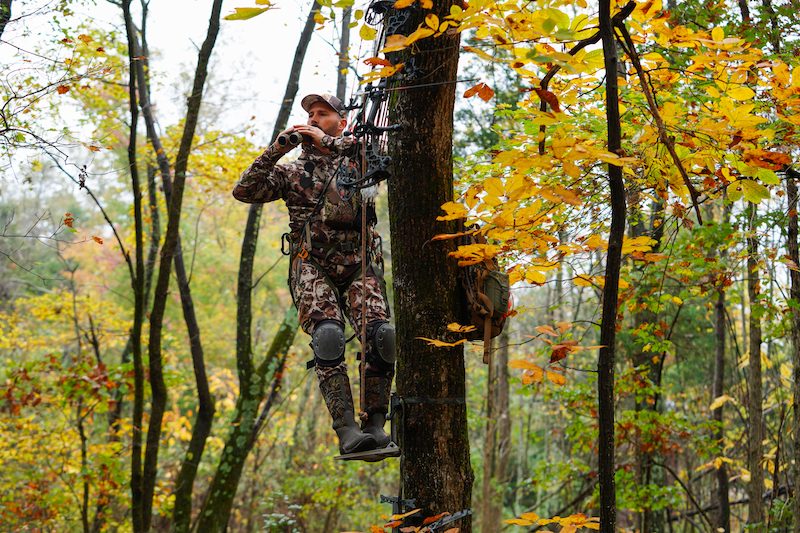I’ll never forget 2020. Many people, including me, faced some tough stuff. And although COVID-19 canceled plenty of my plans, bowhunting wasn’t one of them. This past season was one of my life’s most exhilarating and unexpected times. It reminded me that the more days you spend afield, the more close encounters you’ll have, and the more mistakes you’ll make. All those lessons sharpen your skills.
Hunters swap stories about their adventures for a reason. It’s fun and thrilling to relive and share those hunts, but it’s also important to reflect on each lesson learned afield. I hope what I learned last fall inspires you to look back at your hunts to see how you can improve.
Each elk season I’m reminded that I often hear elk before I see them. Still, it took time to trust my senses. Bugles are easy to hear, but chirping cows and antlers rubbing trees are more subtle.
While trying to stalk through the woods one day last fall, I heard what sounded like a bull raking a tree with its antlers. The day was windy and the timber thick. I could see and hear trees rubbing together, so that might explain the noise. But I stopped instead of dismissing the sound, and slowly raised my binoculars to glass the woods.
I saw no elk at first glance but couldn’t shake the feeling I had heard one. I stood silent 15 minutes before finally seeing it. A cow elk chirped 50 yards ahead of me and walked into view, and another followed. They disappeared before I had a clear shot, and I never saw the bull. Still, if I had ignored my gut and kept moving, I would have missed that close encounter.

Make sure you’re covered and have a clear shooting lane before calling. Photo Credit: John Hafner
Hunting solo provides many benefits, but also some pitfalls. One downside to bowhunting elk alone is that your quarry can pinpoint your location if you try calling. I learned this lesson all too well after setting up in a bad location last season.
A bugle erupted nearby without warning. I was so excited I made a cow call without hesitating. I quickly realized I had rushed the call. The forest floor crunched from dry pine needles, and I stood beside a tangle of downed trees, making it impossible to move without making a racket. I feared one twitch would alert and spook the incoming bull.
Given the bull’s proximity, I tried to conceal myself where I stood. I crouched in front of a tree, hoping to hide my silhouette. A young bull appeared seconds after I nocked my arrow. It stopped with its vitals behind a tree, its eyes locked on me. Seconds later it bolted into the woods. My heart sank. I should have hidden in a place with a shooting lane before calling to the bull.

Review what worked and what didn’t last season and adjust for next season. Photo Credit: ATA
I love elk hunting, so it hurt to skip it on opening day last season. Days before the opener, my husband and I began second-guessing our elk-hunting plans when forecasts called for 100-degree temperatures. The hot weather would make for a tough, miserable hunt. And if we arrowed an elk in the backcountry, it would be tough to pack out all the meat before it spoiled. We chased mule deer instead, and I’m sure glad we did. I filled my tag a few hours into opening day by arrowing a mature buck.
Those were just a few of many lessons from last season. When thinking about your own hunts, evaluate some of these factors:
Safety: Did you follow all protocols when climbing into and out of your treestands? Was your treestand harness reliable and comfortable? Did you carry a first-aid kit? Did your family or friends know your hunting plans?
Shot Placement: Did you practice enough before the season? Did your shot pierce the animal’s vitals? Did you practice judging distances? If you think you need shooting advice, take lessons at an archery shop.
Equipment and Clothing: Did your equipment perform as you expected? Was it quiet? Were you comfortable? Were your boots comfortable? Did you bring too much or too little gear?
Wildlife Sightings: Did you see wildlife? Did you get into bow range? Did you see the wildlife species you were hunting?
Stand/Blind Placement: Did you set up in high-traffic areas? Did you see wildlife? Did you have good shooting lanes?
Overall Enjoyment: Did you enjoy your hunts? If not, what made it disappointing, and how can you make it more enjoyable?
Hunting season goes by too fast. By the time you reflect on those days, you’ve already forgotten some pivotal moments. Some hunters keep a log to help remember each outing. Journals help track everything from weather and sightings, to experiences and outcomes.
By looking back and analyzing your season’s highs and lows, you’ll gain helpful insights that help produce different outcomes later.
So, how was your season and what did you learn?